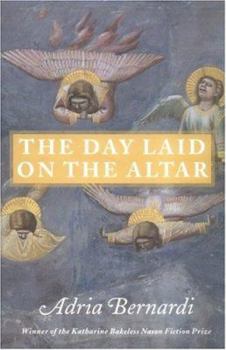The Day Laid on the Altar
Select Format
Select Condition 
Book Overview
A fictional account of the lives of 16th century Italian artisans, artists, and peasants explores their different responses to similiar life-and-death experiences. This description may be from another edition of this product.
Format:Hardcover
Language:English
ISBN:1584650443
ISBN13:9781584650447
Release Date:January 2000
Publisher:University Press of New England
Length:220 Pages
Weight:0.65 lbs.
Dimensions:0.9" x 5.8" x 8.8"
Customer Reviews
3 ratings
To be savored like the finest wine
Published by Thriftbooks.com User , 17 years ago
Adria Bernardi takes her reader deeply and immediately to another place and time--a time of richness and beauty, of struggle and death, and of the triumphs of the great and the small. I could read this book only a chapter per day. The richness of each story had to be reflected upon, digested, and savored. This is one of those books I will treasure always, holding it to my heart long after I have finished reading it. What a precious and beautiful jewel!
Brilliant Depiction of 16th Century Italy
Published by Thriftbooks.com User , 23 years ago
If you are at all interested in art, or have any intrigue with Italy, you'll find this book completely captivating. This book weaves together the lives of Titian Vecellio, his family and servant; Bartolomeo de Bartolai, a shepherd, collector of broken glass and artist-by-night; and Martin de Martinelli, a frescoe craftsman who leaves his friend Bartolai behind in a remote village to pursue work and drink in Florence and Venice. The dangerous world in which the characters live instills in most a passionate commitment to religion as the plague and influenza are frequent visitors upon the characters and those they love. I found the most glorious part of the book at the end when Bartolai is inspired to express his own passionate artistic talent, talent tossed away by a few other characters in spite of their more worldly choices or oppportunities.I found a parallel between the desperate expressions of religion by struggling 16th century Italians who dealt with famine, plague and poverty, and today's USA in which terrorist attacks have created an upsurge in attendance at churches. I find it fascinating that as humans we seek a higher power when the future feels outside of our control.
Like the stones that comprise a mosaic.
Published by Thriftbooks.com User , 24 years ago
In The Day Laid on the Altar, a character discovers an exotic flower shaped like a turban. That flower could serve as a metaphor for the book, which, through chapters that focus on different but related characters, provides poignant and compelling portraits not only of the individual characters, but of the cultures they inhabit. The writing is spare and beautiful, comparable to Michael Ondaatje's or James Salter's, and many paragraphs contain embedded rhymes and rhythms that give the text the feel of poetry.





